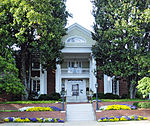Richland Cemetery
1884 establishments in South CarolinaAfrican-American cemeteries in South CarolinaAfrican-American history of South CarolinaCemeteries on the National Register of Historic Places in South CarolinaNational Register of Historic Places in Greenville, South Carolina ... and 2 more
Protected areas of Greenville County, South CarolinaTourist attractions in Greenville, South Carolina

Richland Cemetery is a historic African-American cemetery located at Greenville, South Carolina. It was established in 1884 by the City of Greenville as the first municipal "colored" cemetery. It is the final resting place for many of Greenville's most notable African-American educators, health practitioners, and community leaders. The total number of graves is estimated at over 1,400 and gravemarker types and materials range from natural stones to elaborate Victorian monuments.It was added to the National Register of Historic Places in 2005.
Excerpt from the Wikipedia article Richland Cemetery (License: CC BY-SA 3.0, Authors, Images).Richland Cemetery
Fern Street, Greenville
Geographical coordinates (GPS) Address Nearby Places Show on map
Geographical coordinates (GPS)
| Latitude | Longitude |
|---|---|
| N 34.856638888889 ° | E -82.386888888889 ° |
Address
Fern Street 7
29601 Greenville
South Carolina, United States
Open on Google Maps








